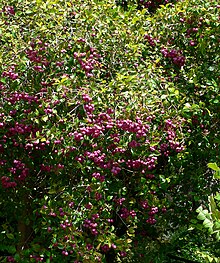Acmena smithii
| Syzygium smithii | |
|---|---|
 |
|
| Scientific classification | |
| Kingdom: | Plantae |
| Clade: | Angiosperms |
| Clade: | Eudicots |
| Clade: | Rosids |
| Order: | Myrtales |
| Family: | Myrtaceae |
| Genus: | Syzygium |
| Species: | S. smithii |
| Binomial name | |
|
Syzygium smithii (Poir.) Nied. |
|
| Synonyms | |
|
Eugenia smithii Poir. |
|
Eugenia smithii Poir.
Acmena smithii (Poir.) Merr. & L.M.Perry
Lomastelma smithii (Poir.) J.H.Willis
Syzygium smithii (formerly Acmena smithii) is a summer-flowering, winter-fruiting evergreen tree, belonging to the myrtle family Myrtaceae. It shares the common name "lilly pilly" with several other plants, however in New Zealand, it is commonly known as 'monkey apple'. It is planted as shrubs or hedgerows, and features: rough, woody bark; cream and green smooth, waxy leaves; flushes of pink new growth; and white to maroon edible berries. Unpruned, it will grow about 3–5 m (9.8–16.4 ft) tall in the garden.
Syzygium smithii 's name dates from its 1789 description as Eugenia smithii by French botanist Jean Louis Marie Poiret, its specific name honouring James Edward Smith, who had described it two years earlier as E. elliptica. The name was unusable due to that combination having been used for another species. It gained its current binomial name in 1893 when reclassified in the genus Syzygium by German botanist Franz Josef Niedenzu, and since 2009 the Council of Heads of Australasian Herbaria (CHAH) Australian Plant Census has confirmed the recognition of this current name. The species has been widely known for many years as Acmena smithii, still used in NSW as of 2009[update], in Qld currently as of July 2013[update], and it still occurs today on many older web pages.
Common names include lilly pilly, coast satinash, Eungella gum, and in the timber trade, lilipilli satinash.
Syzygium smithii grows as a tree to 20 m (66 ft) high by 5–15 m (16–49 ft) wide, with a trunk attaining a diameter of 70 cm (2.3 ft). The largest tree was recorded at Dingo Creek Flora Reserve, south of Tenterfield, being 30 m (98 ft) tall and a trunk 60 cm (2.0 ft) wide.
...
Wikipedia
